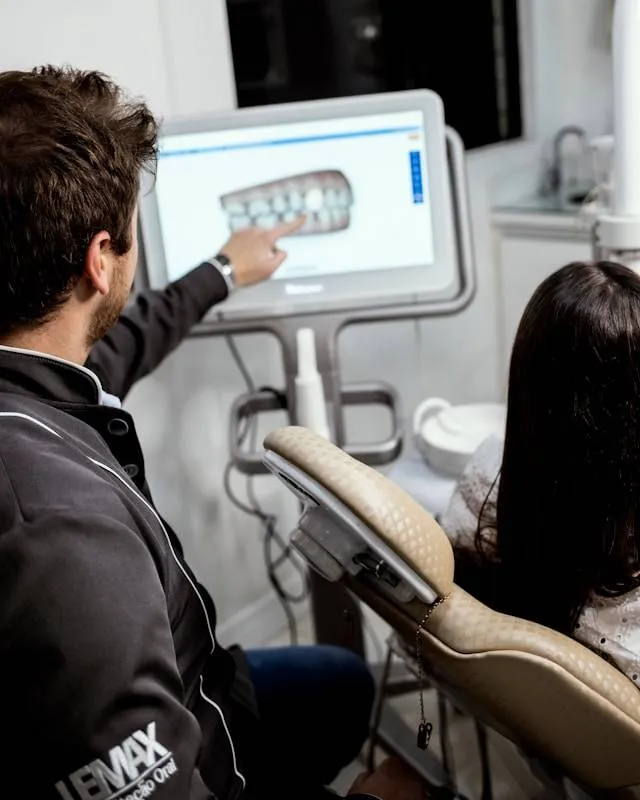1. What is a standard bite?
A perfect bite is an ideal state where the upper and lower teeth fit together perfectly. It represents a harmonious relationship between the teeth of the upper and lower jaws when they come into contact with each other, both at rest and during activity.
When you have a good bite, your teeth will line up and fit together naturally. This not only creates a beautiful smile but also ensures effective chewing function and good oral health.
2. Characteristics of standard bite
A bite is considered standard when it has the following characteristics:
- The upper incisors cover about 1/3 of the lower incisors.
- The midline of the upper and lower incisors is aligned with the midline of the face.
- The upper teeth overlap slightly compared to the lower teeth.
- When biting, the teeth contact each other evenly and tightly.
- Even spacing between teeth, no large gaps
- When viewed from the side, the curve of the teeth harmonizes with the curve of the lower lip.
A standard bite creates balance and harmony for the entire face, not just the mouth.
3. The importance of a standard bite
A good bite is more than just a cosmetic issue. It has important implications for your oral health and quality of life:
- Good chewing function: When teeth fit properly, you can chew food more effectively, helping with better digestion.
- Clear pronunciation: Correct tooth position helps you pronounce more accurately and clearly.
- Tooth protection: Standard bite helps distribute chewing force evenly, reducing the risk of tooth wear or cracking.
- Prevent temporomandibular joint problems: An incorrect bite can cause muscle tension and temporomandibular joint pain.
- Maintain gum health: Straight teeth are easier to clean, helping to prevent gum disease.
- Increased confidence: A beautiful smile with a standard bite helps you feel more confident in communication.

4. Common types of bite
In addition to standard bite, there are some other common types of bite:
- Class II bite (buck teeth): The upper teeth protrude too much compared to the lower teeth.
- Class III bite (underbite): Lower teeth protrude before upper teeth.
- Open bite: When biting, the upper and lower teeth do not come into contact, creating a gap between the two jaws.
- Crossbite: Some of the upper teeth lie inside the lower teeth when biting.
- Deep bite: The upper front teeth cover too much of the lower front teeth.
- Crowded teeth: Teeth grow too close together, overlapping each other.
Each of these types of bites can cause different functional and aesthetic problems.
5. Causes of malocclusion
There are many factors that can lead to malocclusion:
- Genetics: Jaw and tooth shape can be inherited from parents.
- Bad habits when young: Thumb sucking, tongue thrusting, and pacifier use for too long can affect jaw development.
- Early tooth loss: When baby teeth fall out early, surrounding teeth can shift, causing misaligned bite.
- Trauma: Accidents that affect the teeth or jawbone can cause malocclusion.
- Mouth breathing: Frequent mouth breathing can affect jaw development.
- Pathology: Some diseases such as tonsillitis and nasal polyps can cause difficulty breathing, leading to malocclusion.
- Nutrition: An inadequate diet can affect the development of jaw bones and teeth.
Understanding the causes can help you prevent malocclusion or get appropriate treatment.
6. How to recognize a standard bite
You can check your bite yourself by doing the following:
- Stand in front of the mirror and grit your teeth.
- Observe the position of the upper incisors compared to the lower incisors.
- Check that the lines between the upper and lower front teeth are aligned.
- Look sideways to see if the curve of the teeth is in harmony with the lower lip.
- Bite a thin piece of paper between your teeth to check for even contact.
However, for the most accurate assessment, you should see a dentist for a thorough examination.
7. Bite adjustment method
If you are not lucky enough to have a perfect bite, don't worry! There are many methods to correct your bite:
- Braces: This is the most common method to correct tooth position and bite. Braces can last from 18 to 36 months depending on the case.
- Braces: Use metal or ceramic brackets attached to the teeth to adjust the position of the teeth.
- Clear aligners: Use clear plastic aligners to gradually move teeth into the desired position.
- Jaw surgery: In cases of severe jaw misalignment, surgery may be necessary.
- Bite correction grinding: This technique is applied to cases of mild misalignment, by grinding away a small part of the tooth surface.
- Fillings or crowns: Sometimes, changing the shape of the tooth with fillings or crowns can improve the bite.
The choice of method depends on the degree of bite misalignment and the advice of the dentist.

8. How to maintain a standard bite
Once you have achieved a good bite, maintaining it is also important:
- Wear a retainer: After braces, you need to wear a retainer as prescribed by your doctor to keep your teeth in their new position.
- Proper oral hygiene: Brush teeth at least twice a day, use dental floss daily.
- Avoid bad habits: Do not bite your nails, chew hard objects, or use your teeth to open bottle caps.
- Regular dental check-ups: Visit the dentist every 6 months to check your teeth and bite.
- Treat dental problems early: If there are any unusual signs, see a doctor immediately to avoid affecting the bite.
- Healthy diet: Eat lots of green vegetables, fruits, and calcium-rich foods to maintain healthy teeth and jawbones.
9. Frequently asked questions about standard bite
1. Can a standard bite change over time?
Yes, your bite can change due to many factors such as age, tooth loss, or bad habits. Therefore, regular maintenance and check-ups are important.
2. Does everyone need a perfect bite?
Not necessarily. Some people can have a bite that is not perfectly correct and still have no functional or aesthetic problems.
3. Does braces hurt?
In the beginning, you may feel some discomfort, but the pain is usually mild and will gradually decrease over time.
4. Can bite be adjusted in adults?
It is possible, but the process may take longer than it does for children and teenagers. However, it is never too late to improve your bite.
5. Does a standard bite affect overall health?
Yes, a proper bite not only affects your dental health, but can also impact digestion, reduce head and neck pain, improve body posture, and can even affect the quality of your sleep.
6. Are there any natural ways to improve my bite?
While professional methods like braces are most effective, certain habits can help improve your bite slightly, such as practicing proper breathing, exercising your jaw muscles, and avoiding bad habits like thumb sucking.
7. Does a standard bite affect pronunciation?
Yes, a correct bite helps you pronounce words more clearly and accurately. On the contrary, a misaligned bite can make it difficult to pronounce certain sounds.
8. How do I know if my child needs bite adjustment?
Children should have regular dental check-ups from the time their baby teeth appear. The dentist will monitor the development of their teeth and bite, and give advice when necessary.
9. Do all malocclusions need treatment?
Not all. Some mild malocclusions may not require treatment if they do not cause functional or cosmetic problems. However, it is advisable to consult a doctor for an accurate assessment.
10. Does a good bite have anything to do with bad breath?
A correct bite makes it easier to clean your teeth, thereby reducing the risk of tooth decay and gingivitis - the main causes of bad breath.
Conclude
A good bite plays an important role in your oral health and quality of life. It not only gives you a beautiful smile but also ensures good chewing function, clear pronunciation and prevents many other health problems.
If you are concerned about your bite or your child's bite, do not hesitate to seek advice from your dentist. With the development of modern dental technology, bite correction has become easier and more effective than ever.
Remember, a healthy smile starts with a good bite. Taking care of your bite is an investment in your future health and self-confidence. No matter your age, it’s never too late to care about your bite. Start your journey to a good bite today!





